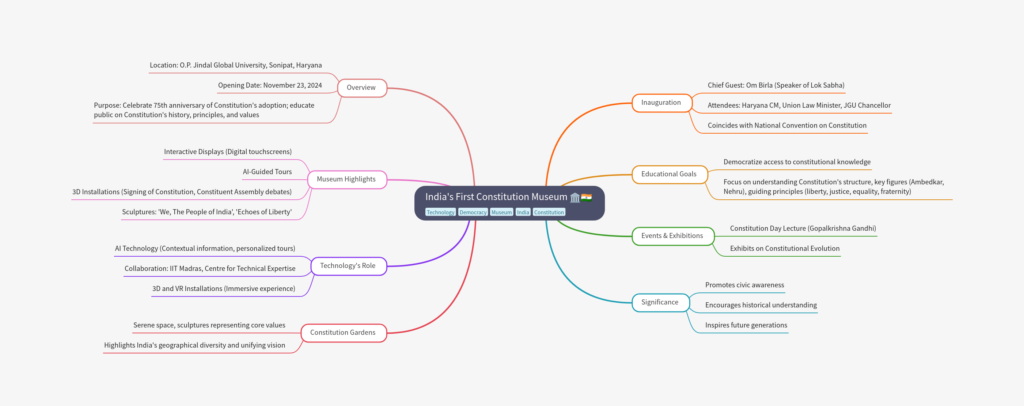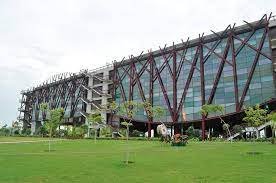Table of Contents

Introduction
India has recently celebrated a significant milestone in its democratic journey with the inauguration of the first-ever Constitution Museum at O.P. Jindal Global University (JGU) in Sonipat, Haryana. Opened on November 23, 2024, the museum is more than a simple exhibition; it’s a vibrant and educational celebration of India’s democracy. As part of the 75th anniversary of the Constitution’s adoption, this museum aims to bring the history, principles, and values of the Constitution to life in an engaging and interactive way.
A Tribute to the Indian Constitution: Celebrating 75 Years of Democracy
India’s Constitution, adopted on November 26, 1949, and enacted on January 26, 1950, is the backbone of the country’s democracy. To commemorate its 75-year journey, O.P. Jindal Global University has created a museum that is a living tribute to the architects of the Constitution and their visionary work.
This landmark initiative was inaugurated by Om Birla, the Speaker of the Lok Sabha, in the presence of esteemed guests like Haryana Chief Minister Nayab Singh Saini, Union Law Minister Arjun Ram Meghwal, and Naveen Jindal, Chancellor of O.P. Jindal Global University. The event was also part of the National Convention on the Constitution of India, reflecting the importance of public awareness and education about the nation’s foundational document.
A Journey Through History: Museum Highlights

The Constitution Museum at JGU isn’t just about displaying old manuscripts or archival photographs. It leverages advanced technology, including AI-driven interactive displays, 3D installations, and virtual reality experiences, to present the Constitution’s history in a way that resonates with modern audiences. Here are some of the key features:
- Interactive Displays: Digital touchscreens allow visitors to explore each section of the Constitution, the history of its amendments, and pivotal moments in Indian democracy.
- AI-Guided Tours: Advanced AI-driven tours provide personalized experiences for visitors, making the museum engaging for students, scholars, and history enthusiasts alike.
- 3D Installations: Life-like 3D representations of significant historical events, like the signing of the Constitution and debates in the Constituent Assembly, immerse visitors in India’s past.
- Sculptures Celebrating Unity and Liberty: The museum is home to beautiful sculptures like ‘We, The People of India’ by Rajesh P. Subramanian, symbolizing the unity and diversity of the nation, and ‘Echoes of Liberty’ by Rahul Gautam, reflecting the core principles of liberty, justice, and equality.
Educational Purpose: Democratizing Access to the Constitution
One of the primary goals of the museum is to make the Constitution more accessible to every citizen, especially the youth, who are the future custodians of India’s democracy. By offering an immersive and multi-format experience, the museum encourages visitors to engage with:
- The structure and sections of the Constitution.
- The contributions of key figures like Dr. B.R. Ambedkar, Jawaharlal Nehru, and other members of the Constituent Assembly.
- The principles that guide India, such as liberty, justice, equality, and fraternity.
This initiative is part of JGU’s mission to democratize access to constitutional knowledge, ensuring that it’s not limited to legal professionals or academics but is open to the general public. Through educational outreach and innovative displays, the museum aims to cultivate a deeper understanding and respect for India’s democratic foundations.
The Role of Technology in Enhancing Learning
The Constitution Museum stands out for its use of cutting-edge technology to bring history to life:
- AI Technology: AI-powered exhibits offer contextual information and guided tours that adapt to the interests of each visitor, providing a unique experience for everyone.
- Collaboration with IIT Madras: The museum’s interactive technology has been developed in collaboration with IIT Madras and the Centre for Technical Expertise, ensuring high-quality, innovative displays.
- 3D and Virtual Reality: These installations create an immersive environment, allowing visitors to step into the shoes of the Constitution’s drafters, witnessing the intense debates and discussions that shaped modern India.
Special Events and Exhibitions
To honor the 75th anniversary, the museum is hosting a series of events:
- Constitution Day Lecture: On November 26, 2024, Gopalkrishna Gandhi, former Governor of West Bengal, will deliver a lecture titled ‘Giving to Ourselves’ – The Constitution of India. This talk is expected to highlight the Constitution’s enduring significance and its relevance for contemporary India.
- Exhibitions on Constitutional Evolution: Special exhibits will showcase the evolution of the Constitution, including its amendments, historical court judgments, and how it has adapted to India’s changing social and political landscape.
Constitution Gardens: An Artistic Ode to Democracy
Adding a unique element to the museum, the Constitution Gardens offer a serene and reflective space for visitors. These gardens are dotted with sculptures that represent the core values enshrined in the Constitution. They not only highlight India’s geographical diversity but also emphasize the unifying vision that the Constitution seeks to uphold.
Why This Museum Matters: A Milestone for India’s Democratic Future
The Constitution Museum is more than just an educational tool; it’s a national treasure that signifies India’s democratic spirit. Here’s why it’s an important addition to the country’s cultural and educational landscape:
- Promotes Civic Awareness: By making the Constitution accessible, it educates citizens about their rights, duties, and the democratic processes that govern the nation.
- Encourages Historical Understanding: The museum’s focus on the Constitution’s evolution helps visitors understand the historical context and significance of key amendments.
- Inspires Future Generations: It’s designed to be especially engaging for younger audiences, fostering a sense of pride and responsibility towards India’s democratic values.
Conclusion:
The opening of India’s first Constitution Museum at O.P. Jindal Global University is a landmark event that marks a new chapter in the way Indians perceive and engage with their Constitution. By combining historical insights with modern technology, it offers an unparalleled experience that is both educational and inspirational. As the museum continues to host special events and exhibitions, it’s set to become a hub for civic education and a testament to India’s democratic ideals.
Whether you’re a student, a legal professional, or simply someone with a passion for Indian history, this museum is a must-visit destination that promises to leave you with a deeper appreciation of the world’s largest democracy.
FAQs
Q1: What is the significance of India’s first Constitution Museum?
Ans: The museum commemorates the 75th anniversary of the Indian Constitution and aims to educate citizens about its history, evolution, and importance in shaping India’s democracy.
Q2: Where is the Constitution Museum located?
The Constitution Museum is located at O.P. Jindal Global University in Sonipat, Haryana.
Q3: What are some unique features of the Constitution Museum?
The museum uses AI-powered guided tours, 3D installations, and interactive displays to create an engaging educational experience.
Q4: Who was involved in the inauguration of the museum?
The museum was inaugurated by Lok Sabha Speaker Om Birla, with the presence of Haryana CM Nayab Singh Saini, Union Law Minister Arjun Ram Meghwal, and other dignitaries.
Q5: What is the purpose of the Constitution Gardens?
The Constitution Gardens feature sculptures that symbolize the principles of the Indian Constitution, offering a reflective space for visitors.
Q6: Why is the Constitution Museum relevant today?
It promotes awareness of the Constitution, educates the public on civic rights and duties, and inspires future generations to appreciate India’s democratic values.
Baddiehub I appreciate you sharing this blog post. Thanks Again. Cool.